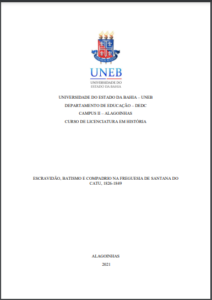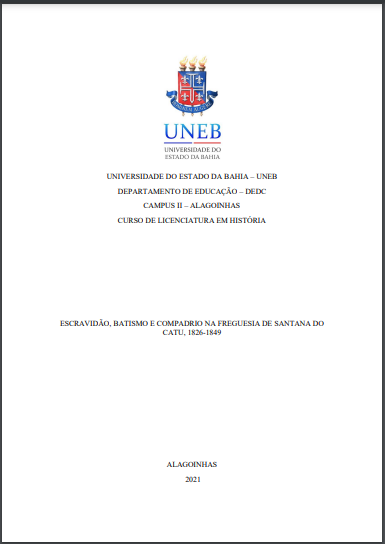AUTORA: SANDI ÍSIS SANTANA DOS SANTOS
ORIENTADORA: PROF.ª DR.ª KÁTIA LORENA NOVAIS ALMEIDA
RESUMO
A presente pesquisa tem como objetivo analisar os registros de batismos contidos em três livros paroquiais da Matriz da Freguesia de Santana do Catu na primeira metade do século XIX, ou seja, entre os anos de 1826 a 1849. Dessa documentação privilegiada, pretendeuse verificar e compreender as relações de compadrio tecidas pela comunidade escrava ali existente, evidenciando o protagonismo dos cativos batizados, seus pais e padrinhos bem como o dos africanos escravizados naquela freguesia rural, periférica, cristã e escravista ao norte do Recôncavo baiano. Os registros eclesiásticos são muito ricos em detalhes e possibilitaram traçar o perfil demográfico da população cativa da referida freguesia e verificar a existência de uniões legitimas e ilegítimas. A documentação viabilizou ainda examinar a atuação dos párocos diante das Constituições Primeiras do Arcebispado da Bahia e a escolha de padrinhos e madrinhas. A constituição espiritual e familiar por meio do compadrio propiciou aos escravos ampliar suas redes de laços afetivos e de solidariedade horizontal e vertical, dessa forma, tal estratégia de sobreviver ao jugo da escravidão demostra o quão esses sujeitos foram ativos e participantes das negociações em que eram feitas na pia batismal com efeito duradouro nos vínculos societários.
Palavras-chave: Escravidão, Batismo, Compadrio, Santana do Catu, Século XIX.
ABSTRACT
This research intends to analyze the baptism registers within three parish books of the Headquarters Freguesia de Santana Do Catu in the first half of the XIX century, therefore, between the years of 1826 to 1849. This privilege documentation, aimed to verify and comprehend the relations of crony created by the slavery community set on that place. Thus showing, the protagonism of baptized captives, your parents, and godfathers similar to the enslaved Africans in that rural freguesy, peripheral, Christian and slaver on the north of the Recôncavo baiano. The ecclesiastic registers are too rich in detailed and, therefore, permited tracing the demographic profile of the captive population of this freguesy, and also alowed verify the existence of lawful and unlawful wedding. The docummentation made it possible to analyze the action of the vicars before the Constituições Primeiras do Arcebispado da Bahia and the choose of the godfathers and godmothers. The spiritual and familiar constitution by the crony provided to the slaves a chance to amplify their affective bonds of the horizontal and vertical solidarity, by that, such strategy to survive the slavery shows how much these individuals were actives and participate in the negotiations made in the baptismal sink with long effect in the social bonds.
Keyword: Slavery, Baptism, Cronyism, Santana do Catu, XIX Century.

ESCRAVIDÃO, BATISMO E COMPADRIO NA FREGUESIA DE SANTANA DO CATU – Sandi Santana – TCC

